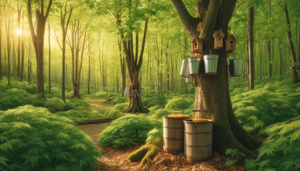Conservation Practices for Maple Producers
Jul 08, 2024
Maple syrup production is more than a time-honored tradition; it's a vital industry cherished by food lovers, breakfast enthusiasts, and culinary artisans. This timeless practice delivers the rich, amber sweetness we adore and plays a crucial role in sustainable agriculture. For maple syrup producers, implementing conservation practices is essential to protect wildlife and maintain the ecological balance of their sugarbushes. Here, we explore specific conservation methods to help preserve the environment and ensure a thriving future for maple syrup production.
Sustainable Forestry Management
Sustainable forestry management is the cornerstone of conservation for maple syrup producers. Producers can maintain healthy forests that support diverse wildlife habitats by adhering to sustainable practices. Key practices include:
- Selective Harvesting: Rather than clear-cutting, producers should engage in selective harvesting to minimize disruption to the ecosystem. This practice involves carefully choosing which trees to tap and ensuring a variety of tree ages and species within the sugarbush.
- Thinning: Periodic thinning of overcrowded areas helps improve tree health and allows more sunlight to reach the forest floor, promoting biodiversity.
- Protecting Water Sources: It is critical to ensure that streams, wetlands, and other water bodies are protected from contamination and erosion. Buffer zones of natural vegetation should be maintained around these areas.
Wildlife Habitat Preservation
Maintaining and enhancing wildlife habitats within the Sugarbush is essential for biodiversity. Maple syrup producers can adopt several strategies:
- Nest Boxes and Shelters: Installing nest boxes and shelters for birds and small mammals can provide safe breeding sites and refuge, particularly in areas where natural cavities are scarce.
- Wildlife Corridors: Creating or maintaining corridors of native vegetation allows wildlife to move freely across the landscape, which is vital for their feeding, mating, and migratory patterns.
- Invasive Species Control: Regular monitoring and controlling invasive plant species help protect native flora and fauna. Producers should implement early detection and rapid response strategies to manage invasive threats.
Soil and Water Conservation
Healthy soil and clean water are fundamental to both forest and wildlife health. Maple syrup producers should focus on:
- Cover Crops: Planting cover crops in open areas helps prevent soil erosion, improves soil structure, and enhances water retention.
- Buffer Strips: Establishing buffer strips of vegetation along waterways reduces runoff, filters pollutants, and provides habitat for beneficial insects and other wildlife.
- Erosion Control: Implementing erosion control measures, such as using mulch and installing silt fences, helps protect soil integrity and water quality.
Integrated Pest Management
Integrated Pest Management (IPM) is an eco-friendly approach to managing pests and diseases that can affect maple trees and the broader ecosystem. Key IPM strategies include:
- Monitoring and Identification: Regular monitoring of pest populations and accurate identification of pests and diseases are crucial for effective management.
- Biological Control: Utilizing natural predators and parasites to control pest populations reduces the need for chemical interventions.
- Cultural Practices: Implementing cultural practices such as crop rotation, sanitation, and resistant tree varieties helps minimize pest outbreaks.
Community Engagement and Education
Educating and involving the community in conservation efforts can amplify the impact of these practices. Maple syrup producers can:
- Host Workshops and Tours: Educate the public about sustainable maple syrup production and conservation practices through workshops, tours, and demonstrations.
- Collaborate with Conservation Organizations: Partnering with local conservation groups can provide additional resources and support for conservation initiatives.
- Promote Eco-Friendly Products: Highlighting the environmental benefits of sustainably produced maple syrup can attract eco-conscious consumers and support market growth.
FAQs
Q: Why is sustainable forestry important for maple syrup production?
A: Sustainable forestry ensures the health of the forest ecosystem, supporting diverse wildlife and long-term maple syrup production.
Q: How do wildlife corridors benefit the sugarbush?
A: Wildlife corridors allow animals to move freely, supporting their natural behaviors and maintaining biodiversity.
Q: What are cover crops, and why are they used?
A: Cover crops are grown to protect and improve soil health, prevent erosion, and enhance water retention.
Q: What is Integrated Pest Management (IPM)?
A: IPM is an approach to managing pests using biological, cultural, and mechanical methods to reduce reliance on chemicals.
Q: How can the community support maple syrup producers in conservation efforts?
A: Participating in educational programs, purchasing eco-friendly products, and supporting local conservation initiatives.


